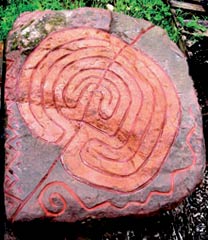
Art and the Garden
There has been comparatively little meaning in English garden design for the past two hundred years. Our garden is a concerted attempt to link research, design and art in an effort to reinvest the English garden with meaning. Today, we live in a world where industrial and technological advances have made human activity affect the climate, worsen the environment, and threaten our very existence. We must look back and remember how to love Nature, internalise the beauty of our environment, and therefore be stimulated to find ways to behave with grace and humility to care for and protect our natural world.
Ancient cultures in the East and the West and also contemporary Stonemasons understand that different types of stone are inhabited by different spirits. All of our garden elements, not just the plants, are alive to the open heart and mind. The garden grows, dwindles and regrows through cycles that spin back into deep time and evokes the aspiration for a return to a moment of harmony, symbolized through the philosopher poet who awaits the return of his love. For the ancient Chinese intellectual, art harmonised human creativity with Earth's. It amplified the plants' spirit and artistic expression and was created within a set of philosophical ideas about landscape, wilderness and the human's place within the cosmic order. Poetry was one art form that was most commonly practiced in association with the gardens. Ancient Chinese poets used their poems to praise the natural beauty that surrounded them and the deep feeling which it aroused. In gardens, poems were written directly onto stone with the meditational and subconscious, abandoned brushstrokes of the calligrapher's art. Flowers, for example, gave warmth and animation to the moods of the poet who needed only to evoke them to effortlessly bloom feeling:
Random Poem
by Wang Wei (701-761)
You come from my home.
What news from there?
Outside my lattice window,
Is the spring light warm yet
For a plum blossom flower?
This short poem portrays an ordinary scene in everyday life: the poet meets someone from his home village but the dense homesickness is held within the image of his little garden plum tree. The next poem depicts the poet's life in a garden, where Nature circled itself, art was composed, and contemplation took place:
Silk-Washing Stream
by Yan Shu (991-1055)
A cup of wine and a new lyric
Same old pavilions in last year's weather
When will the descending Sun be seen again?
Flowers fall whatever one does.
Familiar swallows return once more.
In the little garden, I follow the path alone.
The cycles of Nature are a constant theme. Cycles and spirals can be seen in the art in the garden. Hyatt's painting for the canopy is constructed with a multiple spiral structure and his stone lizard curls in on itself.
In our garden, Erica Wright's 'Brainstones' (Entopica Lithica) are stone mandalas, carved and painted with the Entopic patterns that originate inside the brain, and commonly seen by migraineurs and shamans in trances. They are found in every culture across time and space, and can be considered to be the DNA of art, the fundamental patterns at the heart of it all. Using reclaimed stone and painted with Earth pigments and rainwater, these red sandstone sculptures are infused with the ancient spirit of the Cheshire landscape.
The large scale 'Brainstones' featured in this show are 'The Labyrinth', based on a design found in Bronze Age carvings around the world, 'The Heartstone', which combines a double spiral with classic Entopic parallel line and dots, and 'The Ripplestone', a wishing stone which combines a set of concentric rings with five spirals, to form the board for the 'Tiles of Life' fortune-telling game that is also being featured in this garden, along with Erica's associated entopically-decorated ceramic 'Tiles of Life'. These stones may take the viewer into a meditative state if they are intently focused upon, and highlight the spiritual and contemplative Nature of the garden.
The Chinese garden was a place that enabled people to get immersed in Nature and to be in harmony with it. It was where an intellectual abandoned his thoughts to the flow of Nature or the Tao (the underlying movement of the Universe) and found balance and harmony. In many Buddhist temple gardens, one sees the prevalent use of the spiral in carving and paintings as one does in the artefacts of many even more ancient cultures. Certain forms are repeated throughout human culture that link us with each other and the rest of Nature.
(Poems Translated by Hyatt and Zhou)

The Labyrinth


